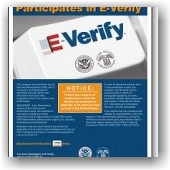Archive for the ‘Immigration News’ Category
Monday, January 26th, 2015

America’s Voice reports; we quote…
The New York Times has released a profile of journalist Jorge Ramos that underscores the political dangers Republicans have created by embracing anti-immigrant policies. Ramos explains the reasons why immigration is such a salient issue for him and many other Latino voters. As he tells Jackie Calmes of the Times:
“immigration is personal. Immigration is the issue that tells us who is with us and who is against us; there’s no question about it. And it’s very simple to understand why — half of all Latinos over 18 years of age were born outside the United States. It really makes no sense to attack them and criticize them if you want their vote.”
As former George W. Bush campaign advisor Matthew Dowd states:
Remember what L.B.J. said, ‘When you lose Walter Cronkite, you’ve lost the war’? [Ramos is] not only a journalist, he’s become the voice of the Latino constituency. And that’s where Republicans have to worry — you don’t want to lose Jorge Ramos.
Tags: Congress, Immigration Legislation, Immigration News, Immigration Reform, Jorge Ramos, Univision
Posted in Congress, Immigration Legislation, Immigration News | Comments Off on Voice of Latino Voters on Univision – Jorge Ramos
Sunday, January 25th, 2015
The U.S. technology industry might finally get the immigration reform that it wants. Bipartisan Senate groups introduced two tech-focused bills this month. The Immigration Innovation Act – which increases the cap on H-1B Visas from 65,000 to 115,000, eliminates per-country limits on visa petitioners and lets spouses of H-1B visa holders work – came out of conversations with corporate tech leaders.
The Startup Act, which already has been introduced on three earlier occasions, creates a new visa category for foreign entrepreneurs.
 For more: http://www.bloombergview.com/articles/2015-01-22/obama-immigration-reform-h-b1-visas-and-silicon-valley
For more: http://www.bloombergview.com/articles/2015-01-22/obama-immigration-reform-h-b1-visas-and-silicon-valley
Tags: Congress, H-1B, High-Skilled Visas, Immigration Legislation, Immigration News, Immigration Reform, Startup Visa, The Immigration Innovation Act
Posted in Congress, H-1B Visas, Immigration Legislation, Immigration News | Comments Off on Obama, High-Skilled Visa Immigration and Silicon Valley
Sunday, December 7th, 2014

On November 20, 2014, President Obama announced efforts to retool critical aspects of the immigration system—how we enforce immigration laws, how we process immigration benefits, how we encourage further business innovation, and how we welcome immigrants to this nation.
Following the address, executive agencies made available intra-agency memoranda and fact sheets detailing specific actions that have already been taken, or will be taken in the future in ten areas within the confines of the law. These actions generally involve border security, the current unlawfully present population, or future legal immigration.
Below we link to Fact Sheets that address the details that we are aware of at this time of the 10 Executive Action Initiatives with links to the memoranda. Additional guidance will be forthcoming.
The expansion of the DACA program that has now removed the age restriction and increases employment authorization from 2 year to 3-year increments, is expected to go into effect on or about February 20, 2015. The implementation of DAPA, the Deferred Action for Parental Accountability, that allows parents of US citizens and lawful permanent residents who have been present in the country since January 1, 2010 to request deferred action and employment authorization, is expected to roll out approximately mid-May 2015.
Resources:
http://www.uscis.gov/immigrationaction
http://www.dhs.gov/immigration-action
http://www.immigrationpolicy.org/special-reports/guide-immigration-accountability-executive-action
Should you have questions at this time or would like to retain our office to assist you or your employees with their immigration matters, please contact us at info@immigrationcompliancegroup.com or call 562 612.3996.
Tags: Business Innovation, DACA, DAPA, Department Of Homeland Security (DHS), Executive Action, H-1B, H-4, I-9 Form, ICE, Immigration News, Immigration Reform, Investor Visas, Undocumented Workers, USCIS
Posted in Comprehensive Immigration Reform, Congress, DACA | DAPA, Department Of Homeland Security (DHS), Employer Compliance, H-1B Visas, I-9/E-Verify News, ICE, Immigration News | Comments Off on Executive Actions on Immigration
Friday, November 21st, 2014

We applaud President Obama’s announcement of broad executive action to offer temporary relief from deportation to millions of undocumented immigrants, stating that the separation of families or the oppression of low-wage immigrant workers is “not who we are as Americans.”
Concurrent with the televised nationwide presidential address last night, the Department of Homeland Security (DHS) Secretary issued a series of memoranda outlining the various facets of the programs and policies which would constitute, in total, “executive action” relating to immigration matters such as: Revising Removal Priorities, ending Secure Communities and replacing it with a New Priority Enforcement Program, expanding DACA, extending DACA to Parents of US citizens and Permanent Residents, revising parole rules, expanding Provisional Waivers to spouses and children, modernizing high-skilled business-related immigration, and more. We link to this information above.
Additional specific information on the initiatives contained in the Executive Action taken by President Obama can be found here
Tags: Congress, DACA, Department Of Homeland Security (DHS), Deportation, Executive Action, H-1B Visas, Immigrant Visas (I-140 Petitions), Immigration News, Immigration Reform, Parole Rules, PERMANENT RESIDENCY, Provisional Waivers, Removal, Securre Communities, Skilled Workers, USCIS
Posted in Comprehensive Immigration Reform, Congress, DACA | DAPA, Department Of Homeland Security (DHS), H-1B Visas, Immigration News, USCIS | Comments Off on The Facts: Fixing a Broken Immigration System Through Executive Action
Tuesday, October 7th, 2014

IMPORTANT INFORMATION
As of January 1, 2015, E-Verify will begin disposing of E-Verify records that are over 10 years old. In order to retain case information, E-Verify employers may download and save the new “Historic Records Report.” If you want a record of your cases that are more than 10 years old, you must download the new Historic Records Report before December 31, 2014. The report will include all transaction records for cases more than 10 years old. The report is only available until December 31, 2014.
NOTE – this Report will ONLY BE AVAILABLE from October 1, through December 31, 2014. The Fact Sheet provides more information as to how to proceed to download applicable E-Verify records.
If you were not using E-Verify on or before December 31, 2004, you do not need to download the report. There will be no records to report. Note that E-Verify will continue this practice on an annual basis.
:::::::::::::::::::::::::::::::::::::::::::::
USCIS Now Offering I-9 Webinars On-Demand
On September 25, 2014, USCIS published the first Form I-9 Webinar On – Demand. Now you can watch the free Form I-9 webinar at any time.
Choose the chapters of your choice or watch the entire 22 minute video in one sitting. You will see how to complete Sections 1, 2 and 3, best practices
and much more. It’s a great training tool. Visit I-9 Central to learn more and view other videos in the multi-media section.
 Form I-9 Webinar on Demand | USCIS uscis.gov
Form I-9 Webinar on Demand | USCIS uscis.gov
Tags: E-Verify, E-Verify Records Retention, Employer Compliance Policy, form I-9, I-9 On-Demand Webinars, I-9/E-Verify News, ICE, Immigration News, OSC, USCIS
Posted in Employer Compliance, I-9/E-Verify News, ICE, Immigration News, OSC, USCIS | Comments Off on E-Verify Records Retention and Disposal | I-9 Webinars On-Demand
Monday, September 15th, 2014

“The decision to simply delay this deeply controversial and possibly unconstitutional unilateral action until after the election — instead of abandoning the idea altogether — smacks of raw politics,” House Speaker John Boehner (R-Ohio) said in a statement which is a total surprise considering the House’s refusal to do anything on immigration reform; is he being sarcastic or untruthful?! Even members from within Obama’s own party scoffed at the decision. Despite this, the White House just last week assured anxious Hispanic lawmakers on Capitol Hill that President Obama will use executive action before the holiday season closes to reform U.S. immigration law, after breaking his pledge to make changes by the end of summer. The message was delivered in a meeting Thursday with White House Chief of Staff Denis McDonough and other administration officials, including domestic policy adviser Cecilia Munoz, a key player for Obama on the issue, according to Politico.
Illinois Democratic Rep. Luis Gutierrez said Obama’s decision to “play it safe” could end up harming his good standing among many Latino voters in the midterms. He further stated, “While we wait until November … there’s going to be another 60,000 people deported,” he said. “There is pain and suffering in the community, and there is a lot of anguish and anger.”
Other resources:
- Latin Post
- Los Angeles Times
- 7 Big Items Congress Won’t Get to this Fall
Tags: Comprehensive Immigration Reform, Congress, DACA, Deportation, Executive Action, Immigration Reform, Immigraton Legislation
Posted in Comprehensive Immigration Reform, Congress, DACA | DAPA, Immigration Legislation, Immigration News | Comments Off on Lawmakers Across Both Parties Blast Obama for Delaying Immigration Reform
Wednesday, May 7th, 2014

Under existing regulations, DHS does not extend employment authorization to dependents (also known as H-4 nonimmigrants) of H-1B nonimmigrant workers. The change proposed by DHS, would allow H-4 dependent spouses of certain H-1B nonimmigrant workers to request employment authorization, as long as the H-1B worker has already started the process of seeking lawful permanent residence through employment.
Eligible individuals would include H-4 dependent spouses of principal H-1B workers who:
- Are the beneficiaries of an approved Form I-140, Immigrant Petition for Alien Worker; or
- Have been granted an extension of their authorized period of stay in the United States under the American Competitiveness in the Twenty-first Century Act of 2000 (AC21) as amended by the 21st Century Department of Justice Appropriations Authorization Act. AC21 permits H-1B workers seeking lawful permanent residence to work and remain in the United States beyond the six-year limit. Refer to AC 21 12/27/2005 Aytes Memo for details.
Proposal to Enhance Opportunities for Highly-Skilled Workers: H-1B1 (Chile and Singapore) and E-3
Specifically, the change to the regulation would:
- Update the regulations to include nonimmigrant high-skilled specialty occupation professionals from Chile and Singapore (H-1B1) and from Australia (E-3) in the list of classes of aliens authorized for employment incident to status with a specific employer.
- Clarify that H-1B1 and principal E-3 nonimmigrants are allowed to work without having to separately apply to DHS for employment authorization. Under current regulations, employers of workers in E-3, H-1B1, or CW-1 status must generally file a petition requesting the extension of the employee’s status well before the initial authorized duration of status expires.
- Allow E-3, H-1B1 and CW-1 nonimmigrant workers up to 240 days of continued work authorization beyond the expiration date noted on their Form I-94, Arrival/Departure Record, while the extension request is pending.
It would affect workers in specialty occupation nonimmigrant classifications for professionals from Chile and Singapore (H-1B1) and Australia (E-3), as well as Commonwealth of the Northern Mariana Island (CNMI)-Only Transitional Workers (CW-1).
Finally, this proposal would also expand the current list of evidentiary criteria for employment-based first preference (EB-1) outstanding professors and researchers to allow the submission of evidence comparable to the other forms of evidence already listed in the regulations. This proposal would harmonize the regulations for EB-1 outstanding professors and researchers with other employment-based immigrant categories that already allow for submission of comparable evidence.
Both Notices of Proposed Rulemaking will soon publish in the Federal Register. DHS encourages the public to comment on the proposed rules through www.regulations.gov. All public comments will be considered before the final rules are published and go into effect. We will keep you posted on next steps when this actually becomes effective.
The DHS Press Release
Tags: AC21, Department Of Homeland Security (DHS), DOL, E-3 Spouse Work Authorization, eb-1, eb-2, eb-3, H-1B Specialty Workers, H-1B1 Spouse Work Authorization, H-4 Work Authorization, Immigrant Visas (I-140 Petitions), Immigration News, PERM Labor Certification, USCIS
Posted in Department Of Homeland Security (DHS), Department Of Labor (DOL), H-1B Visas, Immigrant Visas (I-140 Petitions), Immigration News, USCIS | Comments Off on DHS Announces Proposed Rulemaking for H-4 Spouse Work Authorization
Thursday, April 10th, 2014

Though the notice is preliminary and subject to change, it offers over half a million DACA recipients vital information about what they should do to prepare for the road ahead. Refer here
Tags: DACA, DACA Guidance, DACA Renewals, Deferred Action for Childhood Arrivals, Immigration Legislation, Immigration News, Immigration Reform, USCIS
Posted in DACA | DAPA, Immigration Legislation, Immigration News, USCIS | Comments Off on DACA Recipients – USCIS Releases Guidance on the Application Renewal Process
Wednesday, January 22nd, 2014
 If you Previously had an H-1B for Less than 6 Years
If you Previously had an H-1B for Less than 6 Years
Pursuant to § 212(g)7) of the The Act, if you had an H-1B in the past and were in the USA for less than 6 years, you may be eligible to recoup the time that is remaining on the 6-year maximum period of stay to accept employment with a new employer – without being counted against the cap. An example of this would be someone who works for 3 years in H-1B classification and decides to go back to school on an F-1 student visa. This individual would be eligible to apply for an H-1B for the remaining 3 years at any time of the year.
If you are abroad for at least one year, you have the choice to either apply for a “new” cap H-1B for a full 6-year period, or take advantage of the remainder option if you previously had an H-1B.
H-1B 7th Year Extensions – How This Works
If you are the beneficiary of a labor certification or an I-140 petition that was filed 1 year prior to your 6th year in H-1B status, pursuant to §106 of AC21, you are permitted to file for a 7th year extension. You are also permitted, according to §104(c) of AC21, to apply for a 3-year extension of your H-1B when you have an approved I-140 petition and are unable to move forward with filing your permanent residency case due to employment-based immigrant visa country limits (referred to as retrogression).
If you are in the US and out of status due to a layoff, or are abroad, you are entitled to a 7th year extension of your H-1B if your labor certification or I-140 petition was filed before your 6th year in H-1B status with either the sponsoring employer, or with a new employer. You will more than likely be required to consular process your case in these scenarios.
It is recommended that you seek the advice of a skilled immigration professional with the above cases as they are complex in nature.
You can sign up to receive our information here
Tags: Cap-Exempt, DOL, DOS, H-1B, H-1B 7th Year, H-1B Cap, LCA, Remainder Option, Specialty Occupation, USCIS
Posted in Department Of Labor (DOL), Department of State, H-1B Visas, Immigrant Visas (I-140 Petitions), Immigration News, US Consulates, USCIS | Comments Off on Avoiding the H-1B Cap
Wednesday, January 15th, 2014
 There are certain classes of non-profit employers who are exempt from the H-1B cap. The exemption from the cap only applies to institutions of higher education, non-profit research institutions, government research institutions, and non-profits formally affiliated with an exempt educational institution. Let’s discuss this.
There are certain classes of non-profit employers who are exempt from the H-1B cap. The exemption from the cap only applies to institutions of higher education, non-profit research institutions, government research institutions, and non-profits formally affiliated with an exempt educational institution. Let’s discuss this.
Institutions of higher education: Under the definition, an institution of higher education is one which:
- admits students who have completed secondary education;
- is licensed to provide education beyond secondary school;
- provides educational programs for which the institutions award bachelors’ degrees or provide programs of not less than 2 years that are acceptable for full credit toward bachelors’ degrees;
- is a public or nonprofit institution; and
- is accredited or has been granted pre-accreditation status by a recognized accrediting agency.
What does it mean to be related or affiliated to a higher education institution nonprofit entity?
The USCIS states that it is sufficient that a nonprofit entity is related or affiliated to an institution of higher education through shared ownership, control or be somehow affiliated to the higher education institution as a member, branch or subsidiary.
This narrow definition makes the types of non-profits that qualify for this exemption few and far between. For instance, non-profit service, community, policy and arts organizations would not qualify for the exemption from the H-1B cap. Unless the non-profit employer is primarily devoted to research, or is formally affiliated with a university, it will not qualify as a cap-exempt H1B petitioner. Public secondary schools do not qualify for H1B cap-exemption unless they have a formal affiliation agreement with a college or university. However, the exemption does cover certain professionals employed by a for-profit entity but but does when working at an exempt location, as long as the work continues to serve the core mission of the exempt institution, such as a physicians’ practice group affiliated with and located at a university teaching hospital.
Nonprofit Research Organizations | Government Research Organizations: Nonprofit research organizations or governmental research organizations, are defined in 8 CFR 214.2(h)(19)(iii)(C), as follows:
- A nonprofit research organization is an organization that is primarily engaged in basic research and/or applied research.
- A governmental research organization is a United States Government entity whose primary mission is the performance or promotion of basic research and/or applied research.
Basic research is general research to gain more comprehensive knowledge or understanding of the subject under study, without specific applications in mind. Basic research is also research that advances scientific knowledge, but does not have specific immediate commercial objectives although it may be in fields of present or potential commercial interest. It may include research and investigation in the sciences, social sciences, or humanities.
Applied research is research to gain knowledge or understanding to determine the means by which a specific, recognized need may be met. Applied research includes investigations oriented to discovering new scientific knowledge that has specific commercial objectives with respect to products, processes, or services. It may include research and investigation in the sciences, social sciences, or humanities.
Conclusion
It should be noted that all of the criteria above must be met in order for an institution or an organization to qualify for a cap-exempt status for H-1B purposes. Such institutions and organizations can indicate that their H1B filing is cap exempt by marking Form I-129 (Petition of Non-Immigrant Worker) with a “yes” answer to questions 1, 2, or 3 in Part C of the H1B Data Collection and Filing Fee Exemption Supplement. Bear in mind that an employer or a foreign national who wishes to seek H-1B status under a cap-exempt petition must verify that they qualify for the cap exemption under one of the three categories above. It is recommended that you work with an immigration practitioner that understands this casework as the analysis is often complex. If you’d like to become a client of our office, please contact us at info@immigrationcompliancegroup.com or call 562 612-3996.
Tags: Department Of Homeland Security (DHS), DOL, H-1B Exempt Employers, H-1B NonProfits, H-1B Professionals, H-1B Visas, Immigration News, Labor Condition Application, LCA, Specialty Occupation, USCIS
Posted in Department Of Homeland Security (DHS), Department Of Labor (DOL), H-1B Visas, Immigration News, USCIS | Comments Off on Who are H-1B Exempt Employers?









